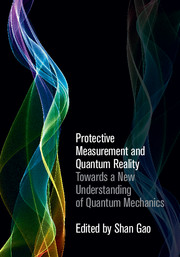Book contents
- Frontmatter
- Dedication
- Contents
- List of Contributors
- Preface
- Acknowledgements
- 1 Protective measurement: an introduction
- Part I Fundamentals and applications
- Part II Meanings and implications
- 7 Measurement and metaphysics
- 8 Protective measurement and the explanatory gambit
- 9 Realism and instrumentalism about the wave function: how should we choose?
- 10 Protective measurement and the PBR theorem
- 11 The roads not taken: empty waves, wave function collapse and protective measurement in quantum theory
- 12 Implications of protective measurement on de Broglie–Bohm trajectories
- 13 Entanglement, scaling, and the meaning of the wave function in protective measurement
- 14 Protective measurement and the nature of the wave function within the primitive ontology approach
- 15 Reality and meaning of the wave function
- Index
- References
11 - The roads not taken: empty waves, wave function collapse and protective measurement in quantum theory
from Part II - Meanings and implications
Published online by Cambridge University Press: 05 January 2015
- Frontmatter
- Dedication
- Contents
- List of Contributors
- Preface
- Acknowledgements
- 1 Protective measurement: an introduction
- Part I Fundamentals and applications
- Part II Meanings and implications
- 7 Measurement and metaphysics
- 8 Protective measurement and the explanatory gambit
- 9 Realism and instrumentalism about the wave function: how should we choose?
- 10 Protective measurement and the PBR theorem
- 11 The roads not taken: empty waves, wave function collapse and protective measurement in quantum theory
- 12 Implications of protective measurement on de Broglie–Bohm trajectories
- 13 Entanglement, scaling, and the meaning of the wave function in protective measurement
- 14 Protective measurement and the nature of the wave function within the primitive ontology approach
- 15 Reality and meaning of the wave function
- Index
- References
Summary
Two roads diverged in a wood, and I –
I took the one less traveled by,
And that has made all the difference.
Robert Frost (1916)The explanatory role of empty waves in quantum theory
In this chapter we are concerned with two classes of interpretations of quantum mechanics: the epistemological (the historically dominant view) and the ontological. The first views the wave function as just a repository of (statistical) information on a physical system. The other treats the wave function primarily as an element of physical reality, whilst generally retaining the statistical interpretation as a secondary property. There is as yet only theoretical justification for the program of modelling quantum matter in terms of an objective spacetime process; that some way of imagining how the quantum world works between measurements is surely better than none. Indeed, a benefit of such an approach can be that “measurements” lose their talismanic aspect and become just typical processes described by the theory.
In the quest to model quantum systems one notes that, whilst the formalism makes reference to “particle” properties such as mass, the linearly evolving wave function ψ(x) does not generally exhibit any feature that could be put into correspondence with a localized particle structure. To turn quantum mechanics into a theory of matter and motion, with real atoms and molecules consisting of particles structured by potentials and forces, it is necessary to bring in independent physical elements not represented in the basic formalism. The notion of an “empty wave” is peculiar to those representatives of this class of extended theories which postulate that the additional physical element is a corpuscle-like entity or point particle. For clarity, we shall develop the discussion in terms of a definite model of this kind whose properties are well understood and which it is established reproduces the empirical content of quantum mechanics: the de Broglie–Bohm theory, a prominent representative of the class of ontological interpretations (Holland, 1993).
- Type
- Chapter
- Information
- Protective Measurement and Quantum RealityTowards a New Understanding of Quantum Mechanics, pp. 145 - 163Publisher: Cambridge University PressPrint publication year: 2015
References
- 1
- Cited by

